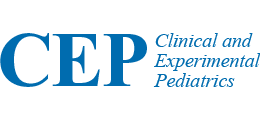All issues > Volume 52(2); 2009
- Case Report
- Korean J Pediatr. 2009;52(2):242-246. Published online February 15, 2009.
- A case of mosaic ring chromosome 13 syndrome
- Soo Young SY Kim1, Soo Min SM O1, Mi Jeong MJ Kim1, Eun Song ES Song1, Young Ok YO Kim1, Young Youn YY Choi1, Young Jong YJ Woo1, Tai Ju TJ Hwang1
- 1Department of Pediatrics, Chonnam National University Medical School, Gwangju, Korea
- Correspondence Young Youn YY Choi ,Email: yychoi@chonnam.ac.kr
- Abstract
- The clinical features of ring chromosome 13 include mental and growth retardation, CNS anomalies, facial dysmorphism, cardiac defects, genital malformations, limb anomalies, skeletal deformities and anal malformations. Although many cases of ring chromosome 13 have been reported worldwide, only 6 cases have been reported in Korea, and the latter cases were not mosaic but pure ring chromosome 13. Here we report a case with mosaic ring chromosome 13. The baby boy was born at 37 weeks of gestation by induced vaginal delivery due to intrauterine growth restriction (IUGR). He was the second baby of a 28-year-old hepatitis B carrier mother and a 32-year-old father. There was no family history of chromosomal anomalies. The baby was a symmetric IUGR with a birth weight of 1,860 g, length of 44.8 cm, and head circumference of 29.4 cm. The physical examination revealed microcephaly, trigonocephaly, flat occiput, large ears, short neck and dysmorphic facial features, including microophthalmia, hypertelorism, antimongoloid slanting palpebral fissures, a flat nasal bridge, and micrognathia. The karyotype of this patient performed by peripheral blood lymphocytes was 46,XY,r(13)(p13q34)/45,XY,-13/46,XY,dic r(13;13)(p13q34;p13q34). The baby showed failure to thrive, hypotonia, and developmental delay. We report the first case of mosaic ring chromosome 13 in a male baby in Korea and compare this case with other Korean cases of non-mosaic ring chromosome 13.
Keywords :Mosaicism, Ring chromosome 13, Facial dysmorphism, Intrauterine growth restriction (IUGR)

 About
About Browse articles
Browse articles For contributors
For contributors
